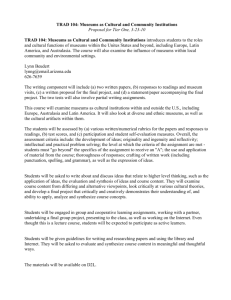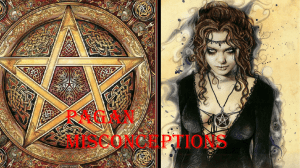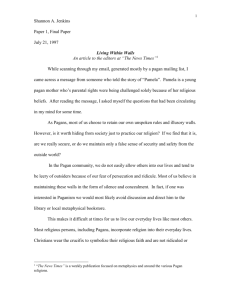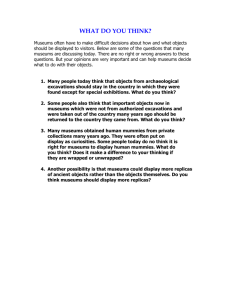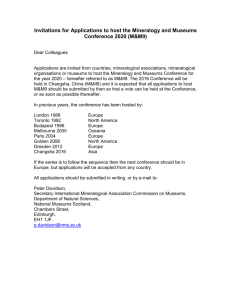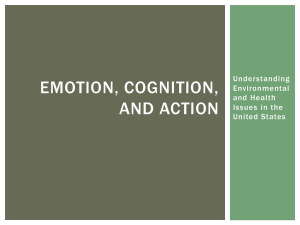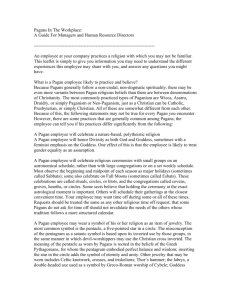Word document - Honouring the Ancient Dead
advertisement
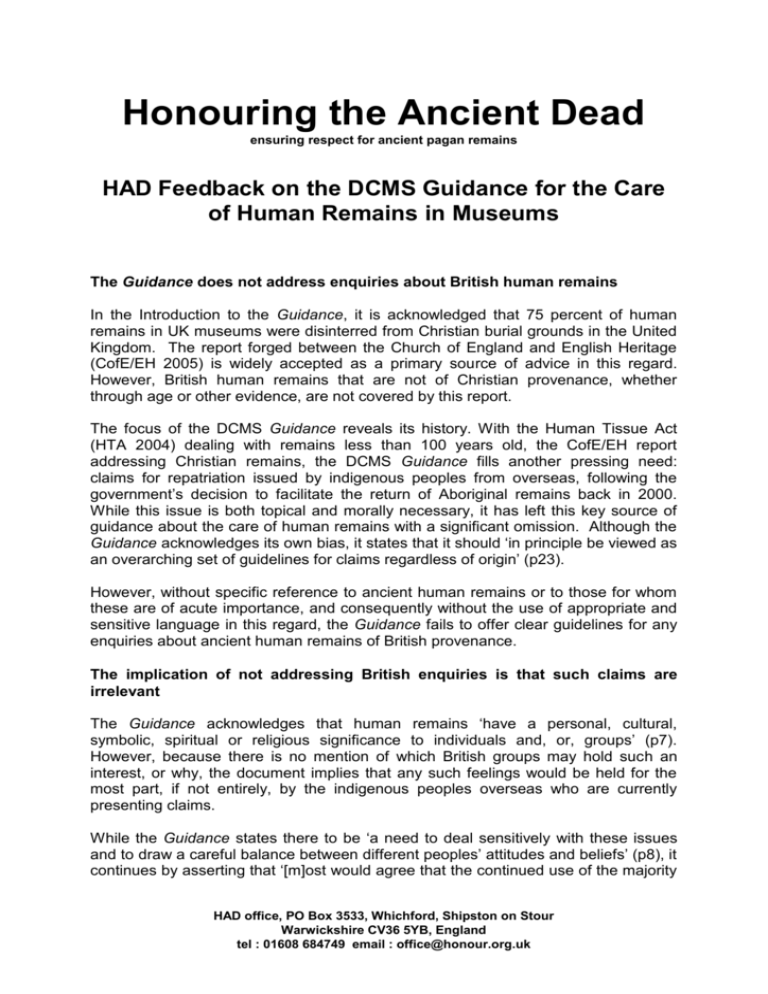
Honouring the Ancient Dead ensuring respect for ancient pagan remains HAD Feedback on the DCMS Guidance for the Care of Human Remains in Museums The Guidance does not address enquiries about British human remains In the Introduction to the Guidance, it is acknowledged that 75 percent of human remains in UK museums were disinterred from Christian burial grounds in the United Kingdom. The report forged between the Church of England and English Heritage (CofE/EH 2005) is widely accepted as a primary source of advice in this regard. However, British human remains that are not of Christian provenance, whether through age or other evidence, are not covered by this report. The focus of the DCMS Guidance reveals its history. With the Human Tissue Act (HTA 2004) dealing with remains less than 100 years old, the CofE/EH report addressing Christian remains, the DCMS Guidance fills another pressing need: claims for repatriation issued by indigenous peoples from overseas, following the government’s decision to facilitate the return of Aboriginal remains back in 2000. While this issue is both topical and morally necessary, it has left this key source of guidance about the care of human remains with a significant omission. Although the Guidance acknowledges its own bias, it states that it should ‘in principle be viewed as an overarching set of guidelines for claims regardless of origin’ (p23). However, without specific reference to ancient human remains or to those for whom these are of acute importance, and consequently without the use of appropriate and sensitive language in this regard, the Guidance fails to offer clear guidelines for any enquiries about ancient human remains of British provenance. The implication of not addressing British enquiries is that such claims are irrelevant The Guidance acknowledges that human remains ‘have a personal, cultural, symbolic, spiritual or religious significance to individuals and, or, groups’ (p7). However, because there is no mention of which British groups may hold such an interest, or why, the document implies that any such feelings would be held for the most part, if not entirely, by the indigenous peoples overseas who are currently presenting claims. While the Guidance states there to be ‘a need to deal sensitively with these issues and to draw a careful balance between different peoples’ attitudes and beliefs’ (p8), it continues by asserting that ‘[m]ost would agree that the continued use of the majority HAD office, PO Box 3533, Whichford, Shipston on Stour Warwickshire CV36 5YB, England tel : 01608 684749 email : office@honour.org.uk of ancient human remains is uncontroversial’. This feedback confirms that such ‘use’ is indeed controversial, and increasingly so. HAD would like to make it emphatically clear that there are many within British culture for whom human remains have a profound personal, cultural, symbolic, spiritual and religious significance. These are not just practising British Pagans, but also individuals and communities who are neither Pagan nor academic for whom ancestry, landscape and heritage are considered of distinct social value or even sacred. However, with no clear mention of ancient and nonChristian British human remains in the Guidance, and thus no clear advice as to how to deal with enquiries about such remains, there is an implication that any such enquiries are not relevant, for they don’t fit into the given framework of guidance. Indeed, the criteria that are laid out within the Guidance that can be used to validate a claim seem based entirely upon the repatriation of human remains usually between 100 - 200 years old. Where there has been interest expressed about ancient British human remains, the response received from museums, archaeologists and other relevant bodies has been, quoting the Guidance, that there cannot be adequate proof with regard to (a) direct, close and proven genealogical descendancy or (b) continuity of belief, customs or language in terms of cultural community. The ‘claim’ criteria are not relevant when we are addressing human remains of British provenance: the issue of ‘cultural community’ in the Guidance is too limited in its scope The relevant paragraph in the Guidance here is: ‘Archaeological and historical study has shown that it is very difficult to demonstrate clear genealogical, cultural or ethnic continuity far into the past, although there are exceptions to this. For these reasons it is considered that claims are unlikely to be successful for any remains over 300 years old, and are unlikely to be considered for remains over 500 years old, except where a very close and continuous geographical, religious, spiritual and cultural link can be demonstrated.’ (p. 27) This paragraph advises a limit in terms of the time period over which legitimate claims to genealogical, cultural or ethnic continuity can be made. If these words decide a case, then most contemporary Pagan claims to a cultural, spiritual or religious link with the preChristian inhabitants of Europe may well be dismissed outright. While academics may discuss and debate contentious issues (within and outside Paganism), this is not an acceptable attitude towards any faith community. Although there are considerable differences between the beliefs and lifestyles of contemporary Pagans and those of preChristian Europeans, the same can be said of the members of any community or religion that are separated by hundreds of years, let alone several thousand. Religious and cultural traditions are dynamic and changing; an unchanging tradition is either an inflexible fundamentalism or a dead tradition. The final sentence of the paragraph, however, reads: ‘Some cultures put more emphasis on association with land that has a cultural, spiritual or religious importance HAD office, PO Box 3533, Whichford, Shipston on Stour Warwickshire CV36 5YB, England tel : 01608 684749 email : office@honour.org.uk and less on relative age. In such cases, the chronological age of the remains may be less significant.’ (p27) This may offer a better way forward. Paganisms can be understood as ‘cultures’ that place a significant emphasis on an association with the land. Perhaps this sentence offers the possibility of legitimating (within this regulatory context) the connection between contemporary Pagans and their preChristian ancestors. Without more specific reference to British claims, it is not clear whether this sentence holds open the possibility of Pagans becoming more fully involved in the care of their ancestors’ remains. Furthermore, as the DCMS Human Remains Advisory Group has found, it is not just Pagans from whom the physical remains of British ancestry are important. Local communities can be equally sensitive and forthright about human remains found within the landscape of their settlement, conurbation or community identity. This cannot be denied: it is now known that the only enquiry submitted to the group since the publication of the Guidance related to preChristian British human remains, and concerned a local community Parish Council requesting the return of those disinterred from their village landscape. Whether or not these early British Saxons are indeed genealogical ancestors of those on the Parish Council is surely not the deciding factor. It is enough for these claimants that they are ancestors of the landscape for which they are responsible and for whom they feel responsibility. The dead are as much a part of their duty of care and their sense of community identity as those who make up the living population. For archaeologists from outside the area to claim full authority to take away those ancient remains, and to claim that the community has no involvement in deciding their future, is simply arrogance and abuse of power. It puts sole authority over ancient human remains into the hands of a small, unelected, distant, disciplinarybased group who have no interest in the local community’s feelings about its heritage. Without clearer guidance within the document about the nature of British Pagan traditions, or heritage and cultural groups for whom British ancestral remains are important, there will continue to be profound doubt as to the ethical base or relevance of the Guidance. The issue of a ‘claim’ is often misunderstood in the context of British human remains While the majority of claims by indigenous people from overseas may be to restore the remains to their own lands and cultures, many ‘claims’ from British people about British ancestors are not demands to remove human remains into the hands of a distinct community. Often a ‘claim’ made is simply an expression of spiritual, cultural or religious interest, where access to the remains is requested. This is particularly relevant where museums have a policy that only genuine and proven academic interest is a valid reason for access to human remains in store. The Guidance does not address this simple point. HAD office, PO Box 3533, Whichford, Shipston on Stour Warwickshire CV36 5YB, England tel : 01608 684749 email : office@honour.org.uk Where a claim for repatriation (to a community local to the site of disinterment) or reburial of human remains of nonChristian British provenance is made, full consultation must be garnered from all interested parties. That the Appendix 1 of the Guidance does not list a single British body that would be relevant in this regard reveals just how significant this omission is in the document. The importance of addressing British enquiries from the Pagan community The Pagan community’s sensitivities towards British human remains must now be heard if bodies are to avoid charges of religious discrimination. While indigenous peoples’ attitudes towards ancestry and heritage are now accepted (if seldom comprehended) by those dealing with human remains, British Pagan beliefs continue to be questioned or dismissed. This lack of acceptance is evident in the Guidance, where there is no language sensitive to Pagan spiritual and religious concerns. Consultation is needed in order to address and amend this problem. Pagans are not asking for exclusive access, but they do demand to be heard and involved, along with other interested parties. Honouring ancestry and the dead is a foundational premise of most Pagan traditions. While within British Paganism there is a range of beliefs, HAD have a council of theologians, individuals who are well respected leaders, thinkers and priests, who speak for the diverse faiths that make up the whole community of traditions. HAD is thus well placed to be involved usefully in such consultation. Given the current problems, HAD now expects to be involved. The importance of addressing British enquiries from the nonPagan community For the vast majority of human remains held in museums the relevant stakeholder communities are the local communities. This is particularly the case where the human remains accessioned to a museum were excavated close by, for there is a widely held sense of the dead being the forebears of modern residents of any given locality (whatever scientific research might reveal). The sense of continuity of human existence and experience in one place is so fundamental that it cannot be ignored; such feelings glue communities together. This point is fully recognized in the human remains policies of Leicester and Manchester Museums, yet not even hinted at in the DCMS Guidance. There should be stated in the Guidance an expectation that representatives of these people be consulted when decisions are made about human remains. The HAD policy on consultation (submitted with this feedback) expresses this comprehensively. The position of archaeologists within the process is not adequately explored in the Guidance. That the document is primarily targeted at museum collections leaves another omission, and one that must be addressed: the Guidance should specifically state that archaeological field units have a duty to follow the same code of practice and the same process of consultation. HAD office, PO Box 3533, Whichford, Shipston on Stour Warwickshire CV36 5YB, England tel : 01608 684749 email : office@honour.org.uk The stakeholders and guardians of the human remains found by an archaeological unit are represented by the local authority within which the excavation took place. The local authority should be fully consulted by the archaeological unit before any decisions are taken about retention or reburial of the remains. The local authority should be responsible for consultation with interested communities about the future of the human remains: archaeological units should not be in a position to make unilateral decisions about who to retain and who to rebury. Furthermore, there is an expectation that communities should be informed and involved in any reburials. The importance of recognising different opinions is stated but disingenuous in the Guidance. The Guidance attempts the difficult and important task of balancing scientific and research aims with religious and cultural values and priorities. While performing this balancing act, however, it is important that all positions be weighed equally, and that some not be allowed to occupy the position of ‘objective’ values and others relegated to mere subjective opinion, or worse still ‘superstition’. In this regard, the following quote is of interest: ‘It is unquestioned that human remains had in the past, and continue to have, a key role in museum research and practice. They have the potential to make major contributions to the furtherance of knowledge, something of value for all humanity.’ (p23) Here, Western science is presented as the universal arbiter of ‘truth’ and value. Indigenous communities from overseas cultures very often have their own stories about human origins, etc, and should not be expected to comply with scientific research agendas for the so-called ‘benefit of all humanity’. While important to many people, the stories that archaeology and other scientific disciplines produce are not necessarily of value to indigenous communities, and these communities cannot necessarily be expected to sacrifice their values and traditions (such as the ways in which the dead are honoured) for ‘scientific advancement’. Further, while this may be (at times reluctantly) accepted by those who are claiming custody of human remains with regard to indigenous peoples of lands overseas, the dismissal of such perspectives as irrelevant and primitive is evident immediately a British person presents a similar worldview. Racial, cultural and religious prejudice and discrimination are endemic within any organisation where such views are quietly acceptable. This is not adequately addressed in the Guidance, where it is enough to be seen to act with political correctness when dealing with foreign visitors, but equally acceptable to publicly dismiss the beliefs of British Pagans as irrelevant. General awareness and transparency within British museums is not adequate. While a constant stream of MA students sends out questionnaires to museums in an attempt to ascertain just what human remains are accessioned where, it is generally understood that the DCMS Scoping Survey was not a comprehensive acquisition of information and is already falling out of date. Museums, furthermore (and particularly local authority museums), are so generally underfunded that documentation, registration and making available information about human remains are beyond their HAD office, PO Box 3533, Whichford, Shipston on Stour Warwickshire CV36 5YB, England tel : 01608 684749 email : office@honour.org.uk functional capacity. It has come to our attention that some museum staff appear not even to have a working knowledge of the DCMS Guidance. While the Guidance is just advisory, not a legally enforceable document, we know of many museums and curators that are not aware of their legal and statutory obligations towards human remains. Consistency as to how the Guidance is being interpreted would also be usefully gathered. Consultation is the key. This feedback is not intended to be a comprehensive list of additions that are required for the Guidance, but shows what is lacking. Full consultation with relevant parties, including HAD for the Pagan community, and others speaking for the cultural, heritage and sociological perspectives of interest in ancient British human remains, must be actioned if the updating of the Guidance is to have any relevance in the future. HAD office, PO Box 3533, Whichford, Shipston on Stour Warwickshire CV36 5YB, England tel : 01608 684749 email : office@honour.org.uk

